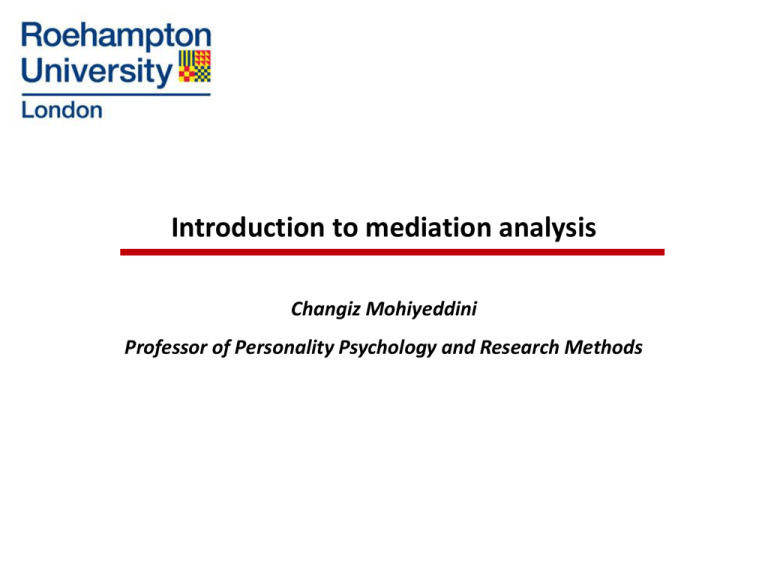Microsoft PowerPoint - the NCRM EPrints Repository
advertisement

Introduction to mediation analysis Changiz Mohiyeddini Professor of Personality Psychology and Research Methods Content 1. Lecture rationale 2. Expected learning outcomes 3. Introduction 4. Rationale of variance explanation 5. Mediation Analysis: How/why can X predict Y? 6. Main conditions of mediation analysis 7. Conducting a mediation analysis 8. Calculating power 9. Interpreting the results 10. Choosing a mediator variable 11. Summary of the lecture Main key words Learning check Reading list 1 Lecture rationale • The prediction of human behavior and experience is a major focus of theory, research, and practice in psychology. • This lecture will give an introduction into mediation analysis. 1 Lecture rationale • The prediction of human behavior and experience is a major focus of theory, research, and practice in psychology. • This lecture will give an introduction into mediation analysis. • Mediation analysis is a tool to explain why one variable can predict another one. • The lecture will explain the rationale of variance explanation, variance prediction and the most crucial conditions of mediation analysis. 2 Expected learning outcomes Students who successfully complete this lecture will be able to demonstrate an understanding of • variance, variance explanation and variance prediction • the purpose of mediation analysis; • the main conditions of mediation analysis; • the process of mediation analysis; • the difference between partial and total mediation 3 Introduction The purpose of scientific psychology: • to describe, explain and predict human experiences and behavior. 3 Introduction The purpose of scientific psychology: • to describe, explain and predict human experiences and behavior. • more precisely: to describe, explain and predict the variance in human experiences and behavior 3 Introduction The purpose of scientific psychology: • to describe, explain and predict human experiences and behavior. • more precisely: to describe, explain and predict the variance in human experiences and behavior • Variance: What dose it mean? 3 Introduction The purpose of scientific psychology: • to describe, explain and predict human experiences and behavior. • more precisely: to describe, explain and predict the variance in human experiences and behavior • Variance: What dose it mean? • Variance means differences 4 Rationale of variance explanation • In general: Explaining a phenomenon means to find the reason why this phenomenon is how it is 4 Rationale of variance explanation • In general: Explaining a phenomenon means to find the reason why this phenomenon is how it is • How do we perform variance explanation in psychology? 4 Rationale of variance explanation • In general: Explaining a phenomenon means to find the reason why this phenomenon is how it is • How do we perform variance explanation in psychology? • We use the variance of one variable to explain the variance of another variable. 4 Rationale of variance explanation Variable y 4 Rationale of variance explanation Population Variable y 4 Rationale of variance explanation Population Sample Variable y 4 Rationale of variance explanation Population Sample Variable x Variable y 4 Rationale of variance explanation Population Sample Intention x Behavior y 4 Rationale of variance explanation Intention x Behavior y 4 Rationale of variance explanation Intention x • Behavior y Are X and Y associated? 4 Rationale of variance explanation Intention x • Behavior y Are X and Y associated? Intention x Behavior y 4 Rationale of variance explanation Intention x Behavior y 4 Rationale of variance explanation 4 Rationale of variance explanation Co-Variance 4 Rationale of variance explanation Co-Variance Correlation 4 Rationale of variance explanation Co-Variance Correlation Positive correlation 4 Rationale of variance explanation Sample Co-Variance Intention Correlation Behavior Positive correlation 4 Rationale of variance explanation Co-Variance Correlation Negative correlation 4 Rationale of variance explanation Sample Co-Variance Intention Correlation Behavior Negative correlation 4 Rationale of variance explanation Co-Variance Correlation 4 Rationale of variance explanation Co-Variance Correlation helps us to understand the variance of a variable 4 Rationale of variance explanation Co-Variance Correlation helps us to understand the variance of a variable Theory Regression helps us to predict the variance of a variable 4 Rationale of variance explanation Co-Variance Correlation helps us to understand the variance of a variable Theory Regression helps us to predict the variance of a variable How? Why? 4 Rationale of variance explanation Co-Variance Correlation helps us to understand the variance of a variable Theory Regression helps us to predict the variance of a variable How? Why? Mediation Analysis 5 Mediation Analysis: How/why can X predict Y? • Mediator analysis establishes "how" or "why" one variable predicts or causes an outcome variable (Baron & Kenny, 1986). 5 Mediation Analysis: How/why can X predict Y? • Mediator analysis establishes "how" or "why" one variable predicts or causes an outcome variable (Baron & Kenny, 1986). • A mediator is defined as a variable that explains the relation between a predictor and an outcome variable (Baron & Kenny, 1986; Holmbeck, 1997). 5 Mediation Analysis: How/why can X predict Y? • Mediator analysis establishes "how" or "why" one variable predicts or causes an outcome variable (Baron & Kenny, 1986). • A mediator is defined as a variable that explains the relation between a predictor and an outcome variable (Baron & Kenny, 1986; Holmbeck, 1997). Mediator Predictor: Intention Outcome: Behavior 5 Mediation Analysis: How/why can X predict Y? • Mediator analysis establishes "how" or "why" one variable predicts or causes an outcome variable (Baron & Kenny, 1986). • A mediator is defined as a variable that explains the relation between a predictor and an outcome variable (Baron & Kenny, 1986; Holmbeck, 1997). Mediator Pos. Emotion Predictor: Intention Outcome: Behavior 6 Main conditions of mediation analysis According to Baron and Kenny (1986; MacKinnon, 2008) 4 conditions must be met when a variable functions as a mediator variable: Mediator: Positive emotions Predictor: Intention Outcome: Behavior 6 Main conditions of mediation analysis According to Baron and Kenny (1986; MacKinnon, 2008) 4 conditions must be met when a variable functions as a mediator variable: Condition 1: The link between the predictor and the outcome variable must be significant. Mediator: Positive emotions Predictor: Intention c Outcome: Behavior 6 Main conditions of mediation analysis Condition 2: The link between the predictor and the mediator variable must be significant. Mediator: Positive emotions a Predictor: Intention Outcome: Behavior 6 Main conditions of mediation analysis Condition 3: the link between the mediator variable and the outcome variable must be significant. Mediator: Positive emotions b Predictor: Intention Outcome: Behavior 6 Main conditions of mediation analysis Condition 4: The mediator variable has to reduce (partial mediation) or eliminate (total mediation) the link between the predictor and the outcome variable. Mediator: Positive emotions b a c Predictor: Intention C’ Outcome: Behavior 7 Calculating Power Path a = Path b More powerful if Path b > Path a 7 Calculating Power Path a = Path b More powerful if Path b > Path a effective sample size: N (1 – rxm2) •N = sample size •and rxm is the correlation between the predictor and the mediator. 7 Calculating Power Path a = Path b More powerful if Path b > Path a effective sample size: N (1 – rxm2) •N = sample size •and rxm is the correlation between the predictor and the mediator. Assuming N = 700 and rxm = .30, the effective sample size is 637. 7 Calculating Power Path a = Path b More powerful if Path b > Path a effective sample size: N (1 – rxm2) •N = sample size •and rxm is the correlation between the predictor and the mediator. Assuming N = 700 and rxm = .30, the effective sample size is 637. If rxm = .60, the effective sample size is 448 ( the sample size is effectively 448 rather than 700). 7 Calculating Power The reliability of the mediator: Specifically, with lower reliability, the effect of the mediator on the outcome variable (Path b) is underestimated and the effect of the predictor variable on the outcome variable (Path c’) is overestimated 7 Calculating Power The reliability of the mediator: Specifically, with lower reliability, the effect of the mediator on the outcome variable (Path b) is underestimated and the effect of the predictor variable on the outcome variable (Path c’) is overestimated Note: statistical analyses, such as multiple regression, that ignore measurement error underestimate mediation effects. 8 Conducting a mediation analysis Using multiple regression: 1. the outcome variable is regressed on the predictor to establish that there is an effect to mediate (path c) 8 Conducting a mediation analysis Using multiple regression: 1. the outcome variable is regressed on the predictor to establish that there is an effect to mediate (path c) 2. the mediator is regressed on the predictor variable to establish (Path a) 8 Conducting a mediation analysis Using multiple regression: 1. the outcome variable is regressed on the predictor to establish that there is an effect to mediate (path c) 2. the mediator is regressed on the predictor variable to establish (Path a) 3. the outcome variable is regressed on both the predictor and the mediator (Path b and c‘) 8 Conducting a mediation analysis Using multiple regression: 1. the outcome variable is regressed on the predictor to establish that there is an effect to mediate (path c) 2. the mediator is regressed on the predictor variable to establish (Path a) 3. the outcome variable is regressed on both the predictor and the mediator (Path b and c‘) If c‘ = zero, the data are consistent with a total mediation model (i.e., the mediator completely accounts for the relation between the predictor and outcome). If c‘ < c but still greater than zero, the data suggest partial mediation. 8 Conducting a mediation analysis: Step 1 Sep1: the outcome variable is regressed on the predictor (path c) Unstandardized Coefficients Model 1 (Constant) Path C: intention B Standardized Coefficients Std. Error 40.394 1.284 2.952 .345 a. Dependent Variable: training time Beta t .451 Sig. 31.460 .000 8.547 .000 8 Conducting a mediation analysis: Step 1 Mediator: Positive emotions C = 2.95 (Sec = .345, β = .45) Predictor: Intention Outcome: Behavior 8 Conducting a mediation analysis: Step 2 Step2: the mediator is regressed on the predictor variable (Path a) Unstandardized Coefficients Model 1 (Constant) Path a: intention B Standardized Coefficients Std. Error 1.628 .450 a. Dependent Variable: positive emotions .218 .059 Beta t .413 7.458 7.661 Sig. .000 .000 8 Conducting a mediation analysis: Step2 Mediator: Positive emotions a = 0.45 (Sea = .059, β = .41) C = 2.95 (Sec = .345, β = .45) Predictor: Intention Outcome: Behavior 8 Conducting a mediation analysis: Step 3 Step3: the outcome variable is regressed on both the predictor and the mediator (Path b and c‘) Unstandardized Coefficients Model 1 (Constant) B Standardized Coefficients Std. Error 36.664 1.295 Path c’: Intention 1.921 .350 Path b: positive emotions 2.291 .321 Beta t Sig. 28.317 .000 .294 5.492 .000 .382 7.138 .000 8 Conducting a mediation analysis: Step 3 Mediator: Positive emotions a = 0.45 (Sea = .059, β = .41) b = 2.29 (Seb = .321, β = .384) C = 2.95 (Sec = .345, β = .45) Predictor: Intention C’ = 1.92 (Sec’ = .35, β = .29) Outcome: Behavior 8 Conducting a mediation analysis: Step 4 Mediator: Positive emotions a = 0.45 (Sea = .059, β = .41) b = 2.29 (Seb = .321, β = .384) C = 2.95 (Sec = .345, β = .45) Predictor: Intention Outcome: Behavior C’ = 1.92 (Sec’ = .35, β = .29) Is the difference between c and c’ significant? 8 Conducting a mediation analysis • We have to calculate a z score in order to establish the significance of the mediation. 8 Conducting a mediation analysis • We have to calculate a z score in order to establish the significance of the mediation. Sobel test equation z-value = a*b/SQRT(b2*sa2 + a2*sb2) Aroian test equation z-value = a*b/SQRT(b2*sa2 + a2*sb2 + sa2*sb2) Goodman test equation z-value = a*b/SQRT(b2*sa2 + a2*sb2 - sa2*sb2) 8 Conducting a mediation analysis • We have to calculate a z score in order to establish the significance of the mediation. Sobel test equation z-value = a*b/SQRT(b2*sea2 + a2*seb2) a = unstandardized regression coefficient for the association between predictor and mediator. sea = standard error of a. b = unstandardized regression coefficient for the association between the mediator and the outcome (when the predictor is also included in the analysis). seb = standard error of b. Calculating a z score Sobel test equation z-value = a*b/SQRT(b2*sea2 + a2*seb2) Z-Value = 0.45* 2.29/ SQRT (2.292 * 0.592 + 0.452 * .3212) = 5.21 Calculating a z score Sobel test equation z-value = a*b/SQRT(b2*sea2 + a2*seb2) Z-Value = 0.45* 2.29/ SQRT (2.292 * 0.592 + 0.452 * .3212) = 5.21 • If z score > 1.96 the mediation is significant at p = .05 • If z score > 2.46 the mediation is significant at p = .01 9 Interpreting the results Partial or total mediation? A significant partial mediation. Mediator: Positive emotions a = 0.45 (Sea = .059, β = .41) b = 2.29 (Seb = .321, β = .384) C = 2.95 (Sec = .345, β = .45) Predictor: Intention C’ = 1.92 (Sec = .35, β = .29) Outcome: Behavior 9 Interpreting the results Partial or total mediation? A significant partial mediation. • Accordingly, positive emotions are the mechanism through which intention influences behavior. Mediator: Positive emotions a = 0.45 (Sea = .059, β = .41) b = 2.29 (Seb = .321, β = .384) C = 2.95 (Sec = .345, β = .45) Predictor: Intention C’ = 1.92 (Sec = .35, β = .29) Outcome: Behavior 9 Interpreting the results Partial or total mediation? A significant partial mediation. • Accordingly, positive emotions are the mechanism through which intention influences behavior. • Influencing positive emotions is one of the reasons (partial mediation) how intention can influences behavior Mediator: Positive emotions a = 0.45 (Sea = .059, β = .41) b = 2.29 (Seb = .321, β = .384) C = 2.95 (Sec = .345, β = .45) Predictor: Intention C’ = 1.92 (Sec = .35, β = .29) Outcome: Behavior 10 Choosing a mediator variable 10 Choosing a mediator variable Predictor Moderator 10 Choosing a mediator variable Theory Predictor Moderator 11 Summary of the lecture • Mediator analysis establishes "how" or "why" one variable predicts or causes an outcome variable. 11 Summary of the lecture • Mediator analysis establishes "how" or "why" one variable predicts or causes an outcome variable. • A mediator is defined as a variable that (based on a theory) explains the relation between a predictor and an outcome variable. 11 Summary of the lecture • Mediator analysis establishes "how" or "why" one variable predicts or causes an outcome variable. • A mediator is defined as a variable that (based on a theory) explains the relation between a predictor and an outcome variable. • The selection of a variable as predictor, mediator or as outcome variable should be made based on the theory underlying the investigation. Main key words • • • • • • • • • • Variance Variance explanation Variance prediction Correlation Regression Mediation analysis Mediator variable Partial mediation Total mediation Sobel-test Learning check 1. How can we explain the variance of a variable (e.g. happiness)? 2. What is the purpose of mediation analysis? 3. What are the key conditions of mediation analysis? 4. What is the difference between partial mediation vs. total mediation? 5. How can we proof whether a mediation link is substantial? Reading list Key readings Baron, R. M., & Kenny, D. A. (1986). The moderator-mediator variable distinction in social psychological research: Conceptual, strategic, and statistical considerations. Journal of Personality and Social Psychology, 51, 1173-1182. Frazier, P. A., Tix, A. P., & Barron, K. E. (2004). Testing moderator and mediator effects in counseling psychology research. Journal of Counseling Psychology, 51, 115-134. MacKinnon, D. P., Fairchild, A. J., & Fritz, M. S. (2007). Mediation analysis. Annual Review of Psychology, 58, 593-614. Mohiyeddini, C., Pauli, G. & Bauer, S. (2009). The role of emotion in bridging the intention–behaviour gap: The case of sports participation. Psychology of Sport & Exercise. 10, 226-234. Mohiyeddini, C., Opacka-Juffry, J. & Gross, J. (in press). Emotional Suppression Mediates the Link Between Early Life Stress and Plasma Oxytocin. Mohiyeddini, C. & Stuart, S. (in press). Displacement Behaviour Regulates the Experience of Stress in Men, Stress. Opacka-Juffry, J. & Mohiyeddini, C. (2012). Experience of stress in childhood negatively correlates with plasma oxytocin in healthy young male adults. Stress, 1, 1-10. Reading list Core readings (to deepen your knowledge) Cohen, J. (1988). Statistical power analysis for the behavioral sciences (rev. ed.). Hillsdale, NJ: Erlbaum. Fritz, M. S., & MacKinnon, D. P. (2007). Required sample size to detect the mediated effect. Psychological Science, 18, 233-239 Hoyle, R. H., & Kenny, D. A. (1999). Statistical power and tests of mediation. In R. H. Hoyle (Ed.), Statistical strategies for small sample research. Newbury Park: Sage. MacKinnon, D. P., Lockwood, C. M., Hoffman, J. M., West, S. G., & Sheets, V. (2002). A comparison of methods to test the significance of the mediated effect. Psychological Methods, 7, 83-104. Preacher, K. J., & Kelley, K. (2011). Effect size measures for mediation models: Quantitative strategies for communicating indirect effects. Psychological Methods, 16, 93-115. Shrout, P. E., & Bolger, N. (2002). Mediation in experimental and nonexperimental studies: New procedures and recommendations. Psychological Methods, 7, 422-445. Thank you






